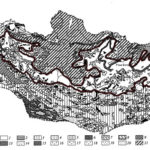UDC 579.26; 631.41
E.P. Nikitina, Buyantueva L.B., Baturina O.A., Gyninova A.B., Lavrentyeva E.V. SPATIAL AND TAXONOMIC STRUCTURE OF SOIL MICROBIAL COMMUNITIES IN THE DRY-STEPPE ZONE OF THE SELENGA MOUNTAINS (WESTERN TRANSBAIKALIA) // Arid Ecosystems. 2023. Vol. 29. № 3 (96). P. 111-123. | PDF
Investigations of soil microbial communities in the dry-steppe zone of the Selenga Mountains have been carried out. The natural and climatic conditions of the region (a long cold period, the small amount of precipitation and uneven distribution during the growing season) cause the formation of mainly chestnut soils with a light granulometric composition, thin humus horizon, low humus and nitrogen content. The article presents data on seasonal dynamics and spatial structure of microbial communities of the studied soils. It was found that the number of different ecological and trophic groups of aerobic chemoorganotrophic bacteria varied from several thousand to several million CFU/g. The highest numbers were observed in the second half of summer. The studied soils had quite similar trends in the spatial distribution of the cultivated part of microbial communities. For hydrolytic bacteria, the highest numbers were noted in humus horizons, for oligotrophic bacteria – in the middle ones. Using high-sequencing we performed a full-profile analysis of the taxonomic structure and diversity of prokaryotic communities of light-humic and chestnut quasi-gley soils. It was found that Bacteria prevailed at the domain level, the number of Archaea was insignificant. The structure of bacterial communities at the phylum level was formed mainly by representatives of Actinobacteria, Acidobacteria, Proteobacteria, Bacteroidetes, Chloroflexi, Verrucomicrobia and Gemmatimonadetes with the dominance of actinobacteria and acidobacteria. Indices of diversity of prokaryotic communities of the genetic horizons of the studied soils were evaluated. It was found that the Shannon and Pielou indices correlated significantly with the content of humus and total nitrogen. During the analysis of beta diversity, it was revealed that microbial communities formed two disjoint clusters that combined humus and mineral horizons of soils when analyzed at the level of orders and lower taxonomic levels.
Keywords: chestnut soils, microbial communities, hydrolytics, oligotrophs, microbial biodiversity, 16S rRNA gene, Selenga Mountains.
Financing. The work was carried for the state task No. 121030100229-1 of the Institute of General and Experimental Biology SB RAS “Microbial Communities of Extreme Natural Ecosystems of the Baikal Region: Structural and Functional Organization and Biotechnological Potential”.
DOI: 10.24412/1993-3916-2023-3-111-123
EDN: GAGPVC





